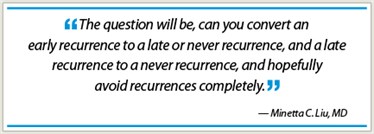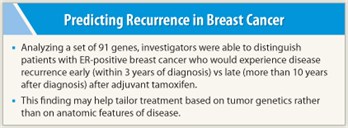A new gene classifier differentiates between women with estrogen receptor (ER)-positive breast cancer who go on to develop metastases early vs late, possibly paving the way for tailored adjuvant therapy.
 Using pretreatment tumor biopsies, a team led by Minetta C. Liu, MD, of the Georgetown University Lombardi Comprehensive Cancer Center in Washington, DC, analyzed the genetic makeup of cancers from 366 women with ER-positive breast cancer who received adjuvant endocrine therapy with tamoxifen alone.
Using pretreatment tumor biopsies, a team led by Minetta C. Liu, MD, of the Georgetown University Lombardi Comprehensive Cancer Center in Washington, DC, analyzed the genetic makeup of cancers from 366 women with ER-positive breast cancer who received adjuvant endocrine therapy with tamoxifen alone.
Analyses identified a set of 91 genes whose altered expression clearly separated patients having a distant recurrence early (within 3 years of diagnosis) from those having such a recurrence late (more than 10 years after diagnosis), according to results reported at the 34th Annual San Antonio Breast Cancer Symposium.1
Reliable Prediction
Certain genes, such as those for the calmodulins and MAP kinase 1, were overexpressed in the former tumors, whereas others, such as those for the estrogen receptors and the androgen receptor, were overexpressed in the latter.
“Robust molecular differences clearly exist between ER-positive breast cancers that recur early vs much later despite adjuvant tamoxifen,” Dr. Liu commented.
 “The reliable prediction of early treatment failure may identify those patients who require agents beyond endocrine therapy to prevent the early onset of distant metastases,” she added. “Exploiting the molecular differences between very early vs late recurrences may guide novel drug combinations in early-stage ER-positive breast cancer,” such as the addition of biologics to endocrine therapy.
“The reliable prediction of early treatment failure may identify those patients who require agents beyond endocrine therapy to prevent the early onset of distant metastases,” she added. “Exploiting the molecular differences between very early vs late recurrences may guide novel drug combinations in early-stage ER-positive breast cancer,” such as the addition of biologics to endocrine therapy.
The findings are being validated further, according to Dr. Liu. Additionally, the investigators are studying the patients whose breast cancers never recurred, again hoping to identify a classifier that can be applied clinically. “The goal is to convert an early recurrence to a late or never recurrence, and a late recurrence to a never recurrence, and hopefully avoid recurrences completely,” she explained.
Also of interest are women treated with adjuvant aromatase inhibitors. Although assessing gene classifiers in this group will be limited by their relatively shorter length of follow-up, doing so “is certainly provocative in this day and age.”
Personalized Medicine
 In a related press conference, Jennifer A. Ligibel, MD, Assistant Professor of Medicine and a breast oncologist at the Dana-Farber Cancer Institute in Boston commended the study as a step toward personalized medicine.
In a related press conference, Jennifer A. Ligibel, MD, Assistant Professor of Medicine and a breast oncologist at the Dana-Farber Cancer Institute in Boston commended the study as a step toward personalized medicine.
“This type of work is very important as we look to individualize the treatment that we give to patients based on their actual tumors rather than on an algorithm based primarily on the anatomic features of their disease,” she said. “This tool may one day allow us to identify patients at risk of early relapse, who may derive benefit from chemotherapy, and patients at risk of late relapse, who may benefit from extended endocrine thereapy.”
Study Rationale and Design
Dr. Liu noted that the molecular basis for different recurrence patterns in ER-positive breast cancer “is largely unknown.”
“Our group hypothesized that early recurrences during tamoxifen treatment exhibit different biological characteristics than those that recurred years later,” she said. “Furthermore, these differences can be identified by looking at variations in the transcriptomes, or the gene patterns from these tumors.”
The investigators analyzed gene expression data generated from tumor biopsies from two cohorts of patients with early ER-positive breast cancer who received adjuvant tamoxifen for approximately 5 years.
One cohort, used as the training set, included 111 patients with stage I through III disease and a median 13-year follow-up, during which time 23% and 20% had an early and late distant recurrence, respectively. The other cohort, used as the validation set, had 255 patients with stage I or II disease and a median 9-year follow-up, during which 10% and 3% had an early and late distant recurrence, respectively.
Key Data
 A classifier based on 91 genes—the majority of which related to proliferation and apoptosis—“essentially separated those patients that were going to recur early vs those that recurred late,” Dr. Liu reported. In receiver-operating characteristic curve analysis, the area under the curve for the classifier was 0.87 in the training set and 0.81 in the validation set.
A classifier based on 91 genes—the majority of which related to proliferation and apoptosis—“essentially separated those patients that were going to recur early vs those that recurred late,” Dr. Liu reported. In receiver-operating characteristic curve analysis, the area under the curve for the classifier was 0.87 in the training set and 0.81 in the validation set.
Statistical network modeling predicted a high level of signaling between many of the affected genes, hinting at some potential mechanistic explanations for the observed clinical behavior.
“We also looked at 5 years vs 10 years [as recurrence intervals] and different time frames,” Dr. Liu noted. “And although the weighted significance of certain genes may vary, the classifier still holds.” ■
Disclosure: Drs. Ligibel and Liu reported no potential conflicts of interest.
Reference
1. Liu MC, Dixon JM, Xuan JJ, et al: Molecular signaling distinguishes early ER positive reast cancer recurrences despite adjuvant tamoxifen. 2011 San Antonio Breast Cancer Symposium. Abstract S1-8. Presented December 7, 2011.

